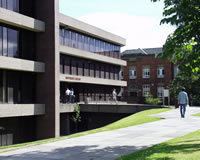Country United Kingdom Established 1833 | Type University Library Location Durham, England | |
 | ||
Branches 5 (Excluding the College Libraries) Items collected Books, journals, newspapers, magazines, sound and music recordings, patents, databases, maps, Parliamentary papers, Mediaeval Seals, European Union Papers, Ecclesiastical Records, Middle East Papers, drawings and manuscripts Budget 4.4 million GBP (2013–2014) | ||
The Durham University Library is the centrally administered library of Durham University in England. It was founded in January 1833 at Palace Green by a 160 volume donation by the then Bishop of Durham, William Van Mildert and now holds over 1.6 million printed items. The University Library comprises five separate libraries:
Contents
- Cosins Library
- Expansion
- Recent history
- List of past librarians
- Heritage research and special collections
- Partnerships
- References
Cosin's Library
After the donation by Bishop William Van Mildert, a suitable location to house the library's stock had to be founded and thus a gallery had to be constructed onto the Cosin's Library (a Diocesan library founded in 1669 by Bishop John Cosin located on Palace Green) in 1834. The original Cosin's library is still located at Palace Green and along with its collection of medieval manuscripts and early printed books came under the trusteeship of the University Library in 1937.
Cosin's Library is a grade one listed building and is located in an UNESCO World Heritage Site. The internal architecture and decoration are also of international importance. The original portrait panels located above the bookshelves were painted by Jan Baptist van Eerssell in 1668-9, further portraits hang in the library including half portraits of English statesmen. Nearly three hundred years later a former University Librarian, David Ramage, completed Cosin's original plan for the library by painting further portrait panels for the smaller room added in 1670-71.
In October 2005, the Museums, Libraries and Archives Council designated the collections in Cosin's Library as having an "outstanding national and international significance".
Expansion
Additional bequeathed or donated collections during the 1850s (most notably by Martin Routh in 1854, Edward Maltby in 1856 and Thomas Mastermann Winterbottom in 1859) led to a further expansion of the library, with the upper two floors of the Exchequer Building (former Bishoprick Law Courts from 1450) being occupied. As the library's stock further expanded more space was gradually needed with a nineteenth-century lecture block eventually becoming part of the Library. A major extension to the Palace Green Library in 1966 designed by architect George Pace provided a reading room and new storage space for the University Library. With no possibility of further expansion on the peninsula, the decision was taken to extend the library building on the University's science site, which became the Main Library in 1983.
Recent history
The University Library has undergone many developments since the 1980s, with the first online circulation system being introduced in 1983, the Main Library won a SCONUL Library Design Award in 1988 and the online cataloguing of the library's stock beginning in 1990. In 1996 the Durham University Library also joined the Consortium of Research Libraries in the British Isles (now Research Libraries UK).
In the succeeding years the University Library was expanded further with an extension of the main library in 1997 and also became the first library in 1998 to incorporate non-Roman scripts into its electronic catalogue system. Further in 2004, the Durham Cathedral Library became part of the University Library's management system for circulation and lending. A further major extension of the Main Library opened in 2012 and shortly afterwards the building was renamed the Bill Bryson Library.
List of past librarians
Heritage, research and special collections
As part of its collection, the library contains a wealth of printed and manuscript material with a particular wealth of material from the medieval period and the Middle East along with materials from the North East. These include:
Partnerships
The University Library is a member of several organisation, including:
